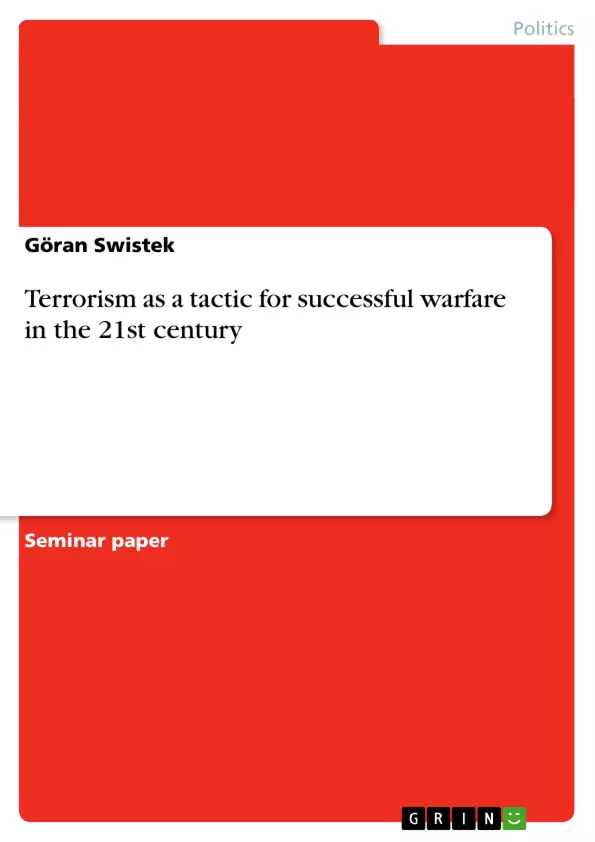Under the term of asymmetric threats or warfare are these actions of combat summarized which deal with the unknown and surprise in terms of timings, ends, ways and means. The party in a conflict using asymmetric strategies and tactics is in comparison to their opponent usually poorly equipped and trained but very elusive and violent in their actions.
In the same context they are often called by their enemies, usually regular forces, as terrorists. They call themselves frequently freedom fighters. Therefore one of the intellectual starting points for this essay is the often used citation, that “One man’s terrorist is another man’s freedom fighter”2. The more or less clear distinction between guerilla’s and terrorist’s used in the mid twenties century is becoming more and more blurred and obsolete3.
The key difference between both, the guerilla warfare and terrorism, was defined by the aims, the means and the targeted group4. Guerilla is a warfare tactic, which is generally used by groups, who lack in conventional military force. They try to hit conventional forces and the government with unconventional means in order to support their political or military agenda.
On the other hand, terrorism was a tactic used by more or less unorganized and less structured groups, aiming as well on governmental as on civilian targets5. Tactics of terrorism are designed to install fear and to de-motivate the enemy. This line which distinguishes both concepts became blurred and obsolete within the last two decades.
Was terrorism once a mean to address and influence the public opinion for the purpose of predominantly political aims, it is now a tool to conduct significant strike against self declared enemies on behalf or by the instrumentalization of religion or politics.
The distinction between guerilla and terrorism is almost not more existing. Terrorism is nowadays a method to use violence against enemies, who have a huge advantage in military power, in order to achieve desired aims by taking the advantage of psychological effects of physical violence7. For this reason, one of the assumptions for this essay is that terrorist tactics might influence modern warfare by installing a new modus operandi, a modified type of warfare. Therefore the central research question guiding this essay is: Are terrorist tactics shaping the modern type of warfare?
Inhaltsverzeichnis (Table of Contents)
- Introduction
- Terrorism as a warfare tactic
- Conclusion
Zielsetzung und Themenschwerpunkte (Objectives and Key Themes)
This essay analyzes the increasing use of terrorist tactics in modern warfare, arguing that these tactics are fundamentally changing the nature of conflict in the 21st century.
- The changing nature of conflicts from interstate to intrastate conflicts
- The blurring of the lines between guerrilla warfare and terrorism
- The impact of terrorist tactics on modern warfare, particularly in relation to psychological effects
- The challenges faced by traditional states in dealing with terrorist tactics
- The implications of terrorist tactics for the future of warfare
Zusammenfassung der Kapitel (Chapter Summaries)
- Introduction: This chapter introduces the topic of terrorism as a warfare tactic, highlighting the shift from traditional warfare to intrastate conflicts involving irregular groups and the difficulty in defining terrorism.
- Terrorism as a Warfare Tactic: This chapter examines the historical context of warfare and the evolution of conflicts, specifically the rise of intrastate conflicts and the impact of asymmetric threats. It analyzes the key differences between guerrilla warfare and terrorism, arguing that the distinction has become blurred in recent years.
Schlüsselwörter (Keywords)
This essay focuses on the key concepts of terrorism, warfare, intrastate conflicts, asymmetric threats, guerrilla warfare, modern warfare, and psychological warfare. It explores the changing nature of conflict and the impact of terrorist tactics on the conduct of warfare in the 21st century.
- Arbeit zitieren
- Dipl. pol., MCGI Göran Swistek (Autor:in), 2012, Terrorism as a tactic for successful warfare in the 21st century, München, GRIN Verlag, https://www.grin.com/document/230331



